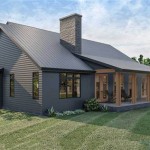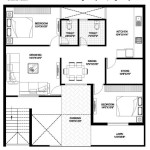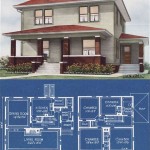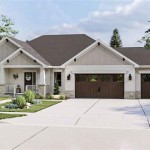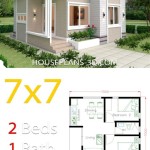Floor Plans For Craftsman Style Homes: An In-Depth Exploration
Craftsman style homes, celebrated for their enduring appeal and emphasis on handcrafted details, have maintained popularity for over a century. Central to their charm is the thoughtful design and functionality reflected in their floor plans. Understanding the common characteristics and variations in these plans is vital for anyone seeking to build, renovate, or simply appreciate the intricacies of this architectural style.
These homes, often associated with the Arts and Crafts movement, prioritize natural materials, open living spaces, and a connection to the outdoors. The floor plan plays a crucial role in achieving these objectives. While there's no single "Craftsman floor plan," certain features consistently appear, shaping the ambiance and usability of the home.
Key Features of Craftsman Home Floor Plans
Several defining characteristics contribute to the distinctive nature of Craftsman house floor plans. Recognizing these elements is essential when differentiating between true Craftsman homes and those that simply incorporate Craftsman-inspired details.
Open Concept Living Areas: While not always fully open in the modern sense, Craftsman homes often feature a less formal separation between living, dining, and kitchen areas. This creates a more communal and connected living space, facilitating interaction and movement. Archways or partial walls frequently define these zones, maintaining some level of visual separation while promoting flow.
The emphasis on open living is a departure from earlier Victorian-era homes, which often had rigidly defined and separated rooms. The goal is to create a more relaxed and inviting atmosphere suitable for both everyday living and entertaining. This design choice also allows for better natural light penetration throughout the central living spaces.
Emphasis on Natural Light: Large windows are a hallmark of Craftsman design, allowing ample natural light to flood the interior. Floor plans are often oriented to maximize sunlight exposure throughout the day, particularly in living areas and bedrooms. The use of multiple windows in each room, often in groupings or banks, further enhances the natural lighting.
Beyond the functional benefit of illumination, natural light is also valued for its aesthetic contribution. It enhances the warmth and richness of the natural materials used in Craftsman home construction, such as wood and stone, highlighting their texture and color variations. Skylights and clerestory windows may also be incorporated to supplement natural light in areas that receive less direct sunlight.
Built-in Features and Storage: Craftsman homes are renowned for their built-in cabinets, bookshelves, and seating. These features are not merely decorative; they are integral to the floor plan and provide practical storage solutions. Built-ins often flank fireplaces, line hallways, or are integrated into dining room walls. This maximizes space utilization and contributes to the overall sense of craftsmanship and attention to detail.
The integration of storage into the floor plan is a key element in Craftsman design. It allows for a clutter-free living environment and reinforces the emphasis on functionality. Built-ins are also often custom-designed to complement the overall style of the home, incorporating materials and finishes that harmonize with the architectural features.
Focus on the Hearth: The fireplace is often a central focal point in Craftsman homes, serving as a gathering place and a source of warmth. Floor plans are often designed to emphasize the fireplace, with seating arrangements and room layouts oriented towards it. The fireplace itself is typically crafted from natural materials like stone or brick and often features a substantial mantelpiece.
The hearth represents a sense of community and comfort, reflecting the values of the Arts and Crafts movement. Its prominence within the floor plan underscores the importance of family life and social interaction. The location of the fireplace often influences the layout of the living room and adjacent spaces, creating a natural flow of movement and conversation.
Common Craftsman Style Floor Plan Variations
While the fundamental characteristics of Craftsman floor plans remain consistent, variations exist depending on factors such as lot size, homeowner preferences, and regional influences. Understanding these variations can help in selecting a floor plan that best suits individual needs and lifestyles.
Bungalow Style:** Bungalows are perhaps the most recognizable expression of Craftsman architecture. Characterized by their low-pitched roofs, wide eaves, and prominent front porches, bungalows typically feature a compact and efficient floor plan. The main living areas are often located on the ground floor, with bedrooms tucked under the eaves or in a partial second story.
Bungalow floor plans often emphasize simplicity and functionality, with an open flow between living and dining areas. The limited square footage necessitates efficient use of space, often incorporating built-in storage and multi-functional rooms. The prominent front porch serves as an extension of the living space, blurring the boundaries between indoors and outdoors. The intimate scale of the bungalow makes it an ideal choice for smaller families or individuals seeking a low-maintenance home.
Two-Story Craftsman:** Two-story Craftsman homes offer more living space than bungalows while retaining the defining characteristics of the style. These homes typically feature a similar layout on the ground floor, with living, dining, and kitchen areas flowing together. The second floor houses the bedrooms and bathrooms, providing a separation between living and sleeping spaces.
Two-story Craftsman floor plans often incorporate a staircase that is a prominent architectural feature, typically located near the entry or living room. The increased square footage allows for larger rooms and more elaborate built-in features. The exterior design often features gabled roofs, dormers, and a combination of materials such as wood, stone, and brick.
Ranch Style Craftsman:** Combining the single-story convenience of a ranch house with Craftsman architectural details, ranch-style Craftsman homes provide an accessible and comfortable living environment. These homes typically feature a long, low profile with a horizontal emphasis. The floor plan is often open and flowing, with all living areas on a single level.
Ranch-style Craftsman floor plans are particularly well-suited for individuals with mobility issues or those seeking a low-maintenance lifestyle. The absence of stairs makes it easier to navigate the home, and the single-story construction simplifies maintenance and upkeep. The exterior design often incorporates Craftsman-inspired details such as wide eaves, exposed rafters, and natural materials.
Craftsman Inspired Modern:** Many modern homes incorporate Craftsman elements to evoke warmth and character. These plans can vary significantly in terms of their layout and style. This often involves using an open floor plan with modern amenities and clean lines, blending in Craftsman details like wood accents, built-ins, and a focus on natural light.
These will often feature large windows and a minimalist aesthetic, while still incorporating elements of natural materials and craftsmanship. The floor plans can cater to a modern lifestyle, with open concept living and flexible spaces. This type of design aims to offer a contemporary aesthetic that still captures the essence of handcrafted charm.
Considerations for Modern Craftsman Floor Plans
While adhering to the traditional principles of Craftsman design, modern floor plans often incorporate contemporary features and technologies to meet the needs of today's homeowners. Careful consideration must be given to balancing historical accuracy with modern convenience.
Modern Amenities:** Incorporating modern appliances, smart home technology, and energy-efficient systems is crucial for creating a comfortable and sustainable living environment. Craftsman homes built today can retain the traditional look while offering all the modern conveniences homeowners expect.
The integration of modern amenities should be done in a way that complements the overall aesthetic of the home. For example, stainless steel appliances can be paired with natural wood cabinets to create a harmonious blend of modern and traditional elements. Smart home technology can be seamlessly integrated into the floor plan, providing enhanced control over lighting, temperature, and security without compromising the classic design.
Space Efficiency:** Optimizing space utilization is particularly important in smaller Craftsman homes or bungalows. Clever storage solutions, multi-functional rooms, and efficient layouts can maximize living space without sacrificing comfort or style. Modern adaptations often integrate open-concept layouts with carefully considered storage and organizational systems to improve space utilization.
Utilizing vertical space is another effective strategy for maximizing space efficiency. Tall cabinets, shelving units, and loft spaces can provide additional storage and living areas without increasing the footprint of the home. Multi-functional rooms, such as a home office that can also serve as a guest bedroom, can adapt to changing needs and lifestyles.
Accessibility:** Designing Craftsman homes with accessibility in mind is increasingly important as homeowners age and seek to remain in their homes for longer. Incorporating features such as wider doorways, ramps, and grab bars can make the home more accessible to individuals with mobility limitations. Modern Craftsman designs often thoughtfully incorporate accessible features within the framework of the original style, creating a comfortable experience for people of all capabilities.
Accessibility features can be integrated seamlessly into the overall design of the home, without compromising its aesthetic appeal. For example, a ramp can be disguised as a gently sloping walkway, and grab bars can be incorporated into decorative bathroom fixtures. Universal design principles prioritize creating spaces that are usable by everyone, regardless of their age or physical abilities.
Sustainability:** Incorporating sustainable building practices and materials is a growing trend in modern Craftsman home design. Using recycled materials, energy-efficient windows, and solar panels can reduce the environmental impact of the home and lower energy costs. Sustainable building practices align with the Craftsman ideals of simplicity, durability, and harmony with nature.
Sustainable materials, such as reclaimed wood and bamboo flooring, can add character and warmth to the home while reducing its environmental footprint. Energy-efficient windows and insulation can minimize heat loss and gain, reducing energy consumption and lowering utility bills. Solar panels can provide a renewable source of energy, further reducing the home's reliance on fossil fuels.
Understanding the nuances of Craftsman floor plans, from their emphasis on open living and natural light to regional variations and modern adaptations, empowers informed decisions for both homeowners and design professionals. By carefully considering these factors, it's possible to create a beautiful, functional, and timeless Craftsman-style home that meets the needs of contemporary living while honoring the legacy of this revered architectural style.

Traditional Style With 3 Bed 2 Bath Car Garage House Plans Dream Craftsman

Craftsman Style House Plans Big And Small Houseplans Blog Com

Bungalow Floor Plans Style Homes Arts And Crafts Bungalows Craftsman House

11 Craftsman House Plans With Photos Blog Homeplans Com

Two Story 5 Bedroom Craftsman Home Floor Plan

Durham Drive Craftsman House Plans Ranch

Craftsman Style Home Plans

Why Does Everyone Love Craftsman House Plans Houseplans Blog Com

2 Story 4 Bedroom Informally Elegant Craftsman Style House Plan

1922 Craftsman Style Bunglow House Plan No L 114 E W Stillwell Co Bungalow Floor Plans

